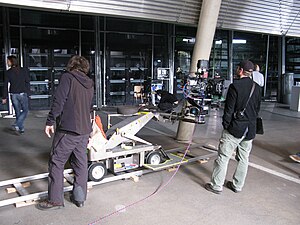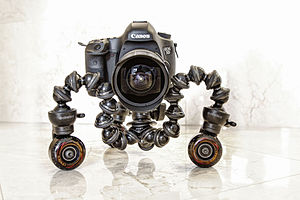


Acamera dolly is a wheeled cart or similar device used in filmmaking and television production to create smooth horizontal camera movements. The camera is mounted to the dolly and the camera operator and focus puller or camera assistant usually ride on the dolly to push the dolly back and forth. The camera dolly is generally used to produce images which involve moving the camera toward or away from a subject while a take is being recorded, a technique known as a "dolly shot". The dolly grip is the dedicated technician trained to operate the dolly by manually pushing it back and forth.[1]
The camera dolly may be used as a shooting platform on any surface but is often raised onto a track, to create smooth movement on a horizontal axis known as a tracking shot. Additionally, most professional film studio dollies have a hydraulic jib arm that raises or lowers the camera on the vertical axis. When a dolly grip operates a dolly on perpendicular axes simultaneously, it's known as a compound move.[2]
Dolly moves may also be executed without track, giving more freedom on the horizontal plane and with it, a higher degree of difficulty. These are called dancefloor moves and may either be done on the existing surface (if smooth enough) or on an overlay designed for dolly movement. The ground overlay usually consists of thick plywood as a bottom layer and masonite on top.[3]
Camera dollies have several steering mechanisms available to the dolly grip. The typical mode is rear-wheel steering, where the front wheels remain fixed, while the wheels closest to the operating handle are used to turn. A second mode, round steering, causes the front wheels to turn in the opposite direction from the rear wheels. This mode allows the dolly to move in smooth circles and is frequently used when the dolly is on curved track. A third mode, called crab steering, is when the front wheels steer in the same direction as the rear wheels. This allows the dolly to move in a direction diagonal to the front end of the dolly. Dolly moment.
This section needs additional citations for verification. Please help improve this articlebyadding citations to reliable sources in this section. Unsourced material may be challenged and removed. (December 2021) (Learn how and when to remove this message)
|

Studio dollies are large and stable and can feature hydraulics. These are the first choice for studio, backlot and location shoots when using professional cameras. A studio dolly usually needs a specialized operator called a "dolly grip", and many are built for the camera operator to ride on the dolly with the camera.
Lightweight dolly systems are more simple and affordable, and are best used with lighter-weight cameras. Lightweight systems are usually favored by independent filmmakers and students because they are easier to carry and operate. These dollies support only the camera, and the operator needs to move alongside. Some lightweight dollies are small enough to be carried in a backpack.
The best way to be able to replicate the same camera movement for multiple takes (which is important for editing) is to use a dolly on track.

In TV production, remote controlled camera dollies are often used for fast but discreet camera movement. A metal rail is laid out for example in front of a stage and a remote controlled dolly is moving the broadcast camera horizontally, where a cameraman would obstruct the view for the audience behind the camera. A common[according to whom?] remote dolly system with camera stabilization is a Blackcam dolly[4][better source needed] with a Newton stabilized camera head.[5][better source needed]
Dolly tracks used for heavy cameras have traditionally been constructed of steeloraluminium. Steel, although heavier than aluminum, is less expensive and withstands heavier use. Longer track segments, while heavier to transport, allow track to be laid straighter with less effort. Curved track is also available. Plastic versions of track have been used with lightweight dolly systems. In the 2000s, flexible rubber track allowed quicker set up and easier transportation for use with light cameras.[citation needed]
|
| |||||||||||||||
|---|---|---|---|---|---|---|---|---|---|---|---|---|---|---|---|
| Lighting |
| ||||||||||||||
| Sound |
| ||||||||||||||
| Shooting |
| ||||||||||||||
| |||||||||||||||